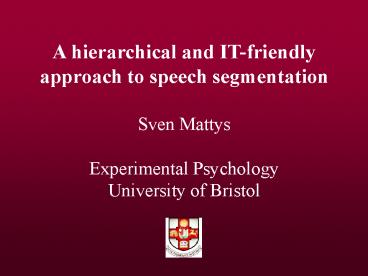A hierarchical and ITfriendly - PowerPoint PPT Presentation
1 / 10
Title:
A hierarchical and ITfriendly
Description:
(d) prosody. II. IMPLICIT SEGMENTATION. Segmentation is a by-product of word. recognition. ... Prosody. Optimal. Poor contextual. information. Poor lexical ... – PowerPoint PPT presentation
Number of Views:31
Avg rating:3.0/5.0
Title: A hierarchical and ITfriendly
1
A hierarchical and IT-friendly approach to speech
segmentation Sven Mattys Experimental
Psychology University of Bristol
2
Illustration of Speech continuity
3
The segmentation challenge
Physical continuity (speech signal) versus Perc
eptual discreteness (words)
They had been comprehensively defeated
1 2 3 4 5
4
I. EXPLICIT SEGMENTATION
- Segmentation precedes recognition.
- Listeners use explicit sub-lexical
- segmentation cues
- (a) coarticulation
- (b) phonotactics
- (c) allophonic variations
- (d) prosody
5
II. IMPLICIT SEGMENTATION
- Segmentation is a by-product of word
- recognition.
- Trade-off Multiple lexical activation.
- Lexical competition naturally settles on best
- parsing solution.
- (e.g., obey-convince vs. o-bacon-vince).
6
Current theories are rather bi-polar
Implicit Segmentation
Explicit Segmentation
but it doesnt have to be that way
7
Interpretive conditions
Segmentation strategies
Pragmatic, semantic, and syntactic context
Optimal
Poor contextual information
Lexical knowledge
Phonotactics Allophones Coarticulation
Poor lexical information
Poor segmental information
Prosody
8
Segmentation cues/strategies are hierarchically
organised
Pragmatic, semantic, and syntactic context
Lexical knowledge
Phonotactics Allophones Coarticulation
Prosody
9
Example of cue conflict Stress vs. coarticulation
comproNO-ta compa-deTE comproNO-ta compa-deTE
Intact
Coartic. gt Stress
Degraded
Stress gt Coartic.
Probed segmentation point
10
CONCLUSION
- The architecture of the model is
language-general but its components are
language-specific.
- Developmentally, the model may build up from the
bottom levels up to more lexically- and
contextually-driven strategies over time.































